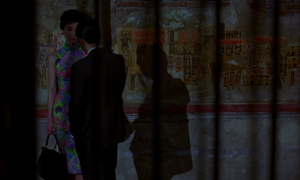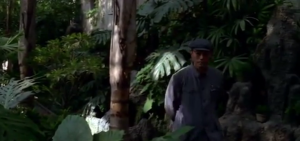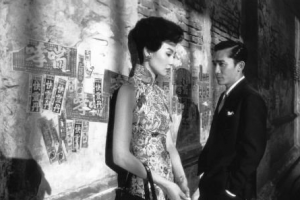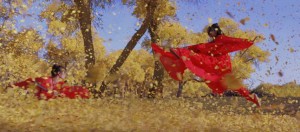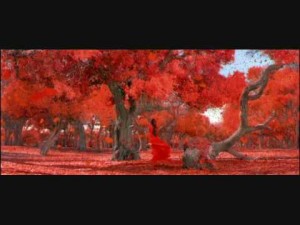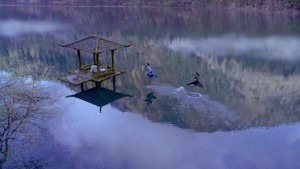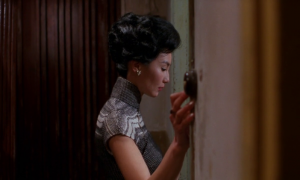The Last Emperor, directed by Bernardo Bertolucci, places special emphasis on the ways in which costumes determine an individual’s status in society. The color and cut of the costumes donned by each character helps the viewer to understand the personality of each character. However, the one sequence within the movie that deviates from this motif is the first sequence in which the prisoners of war recognize Phu-yi’s face and bow to him as if he is still on his throne. I argue that the costume Phu-yi wears during this sequence distinguishes him from the other POWs, and that ultimately his position as emperor transcends his current identity as a POW within Maoist China.
When the viewer first sees Phu-yi in The Last Emperor, he is disembarking a train on the Manchuria-Russia border as a prisoner-of-war. Phu-yi has been brought in for detainment and questioning because he is believed to be a counter-revolutionary.
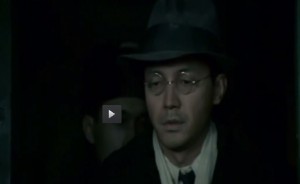
(03:17). A still of Phu-yi as he exits the train (http://putlocker.is/watch-the-last-emperor-online-free-putlocker.html)
The setting where the sequence takes place is dark and industrial. The sky is cloudy, the ground is damp, and the POWs are being escorted by soldiers. All officers are wearing dark-green uniforms, and the other POWs are dressed in winter gear in dark green, dark grey, or black. Phu-yi stands our from the crowd because he is wearing business formal clothing in the form of a suit-and-tie. He wears a fedora instead of a fur-lined winter hat, and he is wearing glasses. From this still, the audience can infer that he was an intellectual, or at least worked in white-collar jobs prior to becoming a POW. When he enters the great-hall where the other POWs are waiting, they all turn to stare at him, with wary recognition. Some of the POWs bow towards him even though that is considered disobedience and could lead to death.
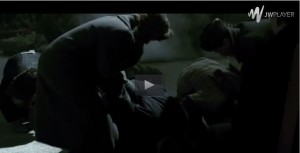
People bowing to greet the Emperor as guards take them away. Phu-yi is in the far-right of the frame, watching in disbelief. (http://putlocker.is/watch-the-last-emperor-online-free-putlocker.html)
This is the only time in the film where Phu-yi’s costume did not accurately portray his identity or indicate to people how he should be treated. As a young child in the height of his reign, Phu-yi was best remembered as wearing the yellow imperial robes. In the photo below Pu yi has emerged from the Forbidden City to conduct a ceremony. Historically, the color yellow is reserved for royalty, and is only worn by the emperor.

Emperor emerging from the forbidden city (https://s3.amazonaws.com/criterion-production/stills/5743-62a71c78f340a4150192cf4a0d3899e2/Film_422w_LastEmperor_original.jpg)
Even when Pu yi is forced to evacuate the Forbidden City, he is still recognized as the Emperor in Japan due to his expensive attire. The Last Emperor proves that costumes are not necessarily indicative of how a character inhabits and navigates the setting around them. The Last Emperor tells Pu yi’s story through flashbacks as he is questioned by the communist army. What matters most for Pu yi is not his current status as a POW, which is implied by the suit he wears entering the prison and the mao suit he is forced to wear during questioning. His story shows that people will remember him as emperor because he served as emperor and wore the robes. His cultural relevance in Chinese collective memory will always command respect from people around him regardless of his official title and the clothing he wears.

 r is he was taken from his home and appointed at the young age of three. A critical aspect of the film is how the emperor’s clothing changes over time in relation to the events that occur around him. To start off, lets begin with the first picture. We see in this picture the three-year-old emperor at his coronation ceremony. He is dressed in traditional Chinese emperor attire that entails the robe, hat and the color yellow. The color yellow is significant because in traditional Chinese culture only the emperor could wear yellow. By him wearing yellow we see that Chinese traditions are still in tacked in this section of the film. Another thing to take notice of in the emperor’s outfit is how large it is. It is interesting to see such a small child in the attire an older man would wear. The proportions facilitate the strangeness of such a young child becoming the ruler of an empire. The next picture is a snap shot of the grown emperor, his wife, and his mistress in a car no longer in the Forbidden City. Th
r is he was taken from his home and appointed at the young age of three. A critical aspect of the film is how the emperor’s clothing changes over time in relation to the events that occur around him. To start off, lets begin with the first picture. We see in this picture the three-year-old emperor at his coronation ceremony. He is dressed in traditional Chinese emperor attire that entails the robe, hat and the color yellow. The color yellow is significant because in traditional Chinese culture only the emperor could wear yellow. By him wearing yellow we see that Chinese traditions are still in tacked in this section of the film. Another thing to take notice of in the emperor’s outfit is how large it is. It is interesting to see such a small child in the attire an older man would wear. The proportions facilitate the strangeness of such a young child becoming the ruler of an empire. The next picture is a snap shot of the grown emperor, his wife, and his mistress in a car no longer in the Forbidden City. Th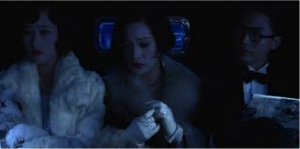 e emperor is wearing a European traditional black and white tuxedo. His women are wearing traditional western dresses and accessories. This outfit change is very noteworthy. We see here that the three are totally disconnected to there traditional past in this point of time. They are no longer in the Forbidden City and have since broken away from that lifestyle. A few more things to notice about the outfits in this scene are the emperor’s glasses and his short hair cut. In traditional Chinese culture the emperor would never wear glasses and never cut his hair. The fact that he has done both shows that he has left his role of emperor in the past and trying to assimilate into western culture. By looking at the contrast of the first and second pictures we can see the transition the emperor had to make as he was kick out of his empirical home. Outfit choices in movies help aid the story line and bring forth important ideas that that are not necessarily spoken.
e emperor is wearing a European traditional black and white tuxedo. His women are wearing traditional western dresses and accessories. This outfit change is very noteworthy. We see here that the three are totally disconnected to there traditional past in this point of time. They are no longer in the Forbidden City and have since broken away from that lifestyle. A few more things to notice about the outfits in this scene are the emperor’s glasses and his short hair cut. In traditional Chinese culture the emperor would never wear glasses and never cut his hair. The fact that he has done both shows that he has left his role of emperor in the past and trying to assimilate into western culture. By looking at the contrast of the first and second pictures we can see the transition the emperor had to make as he was kick out of his empirical home. Outfit choices in movies help aid the story line and bring forth important ideas that that are not necessarily spoken.
